Chauvin Pre-trial Day 4 Midday: 3rd Degree Murder Reinstated, Sixth Juror Seated
Reinstating the charge follows the Minnesota court of appeals decision in the Noor case to change Minnesota law to allow 3rd degree murder to apply even where the danger was to only an individual,
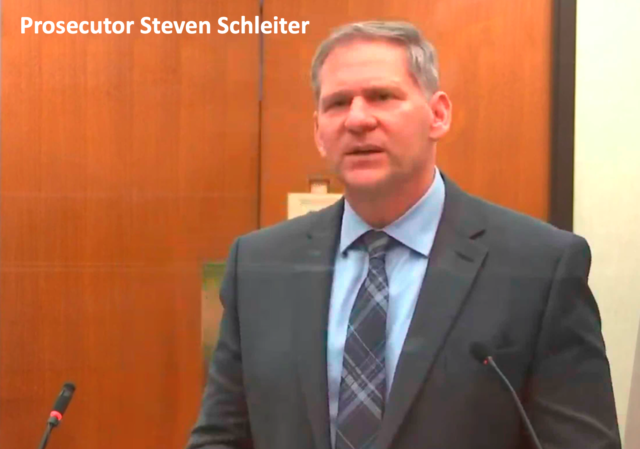
Welcome to our ongoing coverage of the Minnesota murder trial of Derek Chauvin, over the in-custody death of George Floyd. I am Attorney Andrew Branca for Law of Self Defense, providing guest commentary and analysis of this trial for Legal Insurrection.
As a reminder, I am “LIVE Parlering” the trial in real-time over at my Parler account, which you can find using my Parler handle: @LawofSelfDefense.
3rd Degree Murder Charge Reinstated Against Chauvin
This morning the trial court reinstated the 3rd degree murder charge against Chauvin, adding it to the existing charges of 2nd degree murder and 2nd degree manslaughter. The 3rd degree murder charge had, in fact, been the initial murder charge brought against Chauvin when he was first charged.
As a reminder, here’s the relevant part of the 3rd degree murder statute, § 609.205. Manslaughter in the second degree:
A person who causes the death of another by any of the following means is guilty of manslaughter in the second degree and may be sentenced to imprisonment for not more than ten years or to payment of a fine of not more than $ 20,000, or both:
(1) by the person’s culpable negligence whereby the person creates an unreasonable risk, and consciously takes chances of causing death or great bodily harm to another;
The 3rd degree murder charge was then dismissed by Judge Cahill under then-existing law that limited 3rd degree murder to situations involving a general danger to the public, and not to a specific danger to an individual (e.g., in this case, only to Floyd). (In response, the state then charged Chauvin with 2nd degree murder, in its place.)
Since that time, the Minnesota court of appeals decided in the Noor decision to change Minnesota law to allow 3rd degree murder to apply even where the danger was to only an individual, and since then the state prosecutors have been arguing to have 3rd degree murder recharged against Chauvin.
This morning, Judge Cahill did exactly that.
Sixth Jury Seated & State Burns Another Peremptory Challenge
This morning’s voir dire worked through four prospective jurors: #31, #36, #37, and #38. (A fifth jury, #33, was dismissed for cause without even being questioned, based on age and highly limited English language skills.)
Prospective juror #31 was quickly dismissed for cause after a brief in camera (meaning, off microphone) review, so we don’t know why that occurred, but that did away with #33.
Prospective juror #36 is a male described as a route driver. He was acceptable to both the defense and the state, and was seated as a juror. More on him in a moment.
Prospective juror #37 was a female single-mother who described an extremely emotional response to the video of Floyd’s death—she told the court that cried while viewing it and hearing Floyd call out to his mother—and who repeatedly stated that she would be unable to “unsee” that video. She also stated that she would be unhappy with a not guilty verdict.
Over the state’s objections—they thought she would make a perfectly fine, fair and impartial, juror—Judge Cahill ultimately dismissed #37 for cause, so the defense was not obliged to burn a peremptory challenge here.
Prospective juror #38 was a male business owner who lived outside the city of Minneapolis. Much like #29 yesterday, the female lawyer, he indicated that he would arrive at a verdict based on evidence and reason. He also indicated a somewhat favorable view of police, and a somewhat unfavorable view of Black Lives Matter in the context of the riots, arson, and looting in Minneapolis. He indicated he though BLM probably had good intentions but was perhaps highjacked by others intent on violence. He was acceptable to the defense but he was struck by the state using it’s fourth peremptory challenge. This leaves the state with five remaining peremptory challenges.
Juror #36 Seated
Juror #36, a male route driver, described his response to being called to this case as mind-blowing, given the magnitude of the case. He described himself as a family man, outgoing, a sports fan.
He indicated that he could set aside his current opinions and arrive at a fair and impartial verdict based on the evidence shown in court and the instructions given by the judge, even if his believed the law on which he was instructed to be other than what he might prefer. He affirmed he would not arrive at a decision until the end of the trial, needing to “hear every detail.”
Asked if he was willing to stand by what he believed of the evidence, or was prone to be accommodating to achieve consensus, #36 indicated he was willing to stand by his principles.
Juror #36, however, had also drawn some definite opinions about the video that he appeared to be very reluctant to let go. For example, in his juror questionnaire he described the video by writing:
“When Floyd was on floor, Chauvin kneeling on neck the entire time, Floyd desperately screaming that he couldn’t breath, while other officers just let it happen, and bystanders screaming at Chauvin to get off his neck because he was killing him.”
When pressed on this description by the defense which characterized this as opinion, #36 responded:
“I just wrote what I saw. That’s what it was. Everyone will see that [Floyd] was desperate.”
Juror #36 also wrote in his questionnaire:
“There was no reason for Chauvin to kneel on Floyd’s neck for that long, impression of him just showing off his authority.”
When pressed if he had already formed an opinion of Chauvin’s guilt, #36 said he had, but that he was willing to consider all the evidence and witnesses.
Juror #36 had previous interaction with police when he had a car stolen, and he described that experience as favorable.
He also agreed with the sentiment, phrased by defense counsel Nelson, that one should prefer to let 10 guilty people go free than that 1 innocent person be convicted.
Interestingly, when being questioned by Prosecutor Schleiter, it was revealed that #36 had written in his juror questionnaire that none of the Floyd event needed to happen if Floyd had simply complied with police:
He did concede, however, that just because Floyd may have been non-compliant at the start did not necessarily excuse what happened later.
Finally, #36 somewhat disagreed that the criminal justice system was biased against blacks and minorities. (Perhaps worth noting that it sounded to my admittedly untrained ear as if #36 had a slight Hispanic accent.)
Here’s the video of the voir dire of #36 (as usual, dead space deleted, otherwise complete):
And that’s it for this morning’s events in Minnesota v. Chauvin! We’ll continue to cover the case live on Parler this afternoon, and plan on an end-of day blog post this evening to share those later events with you.
Until next time, stay safe!
–Andrew
Attorney Andrew F. Branca
Law of Self Defense LLC
Attorney Andrew F. Branca’s legal practice has specialized exclusively in use-of-force law for thirty years. Andrew provides use-of-force legal consultancy services to attorneys across the country, as well as near-daily use-of-force law insight, expertise, and education to lawyers and non-lawyers alike in the form of blog posts, video, and podcasts, through the Law of Self Defense Membership service. If this kind of content is of interest to you, try out our two-week Membership trial for a mere 99 cents, with a 200% no-question- asked money-back guarantee, here: Law of Self Defense Membership Trial.
[Featured image is a screen capture from video of today’s court proceedings in MN v. Chauvin.]
Donations tax deductible
to the full extent allowed by law.

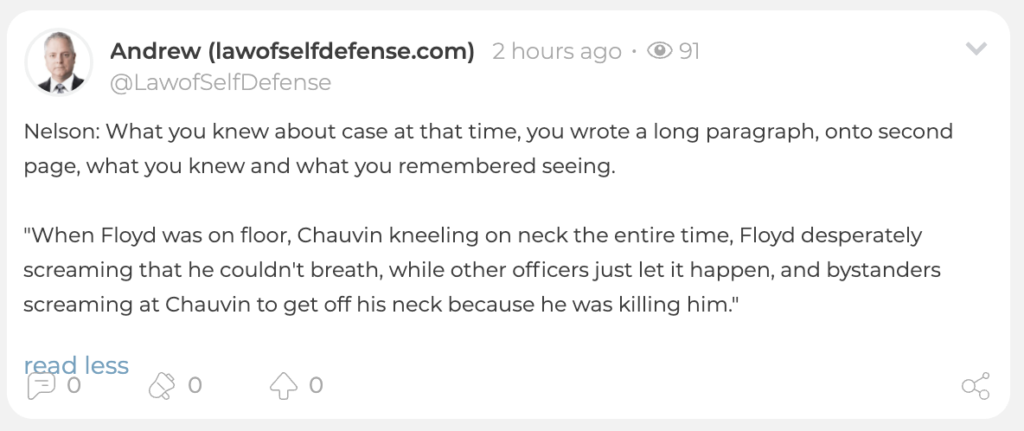
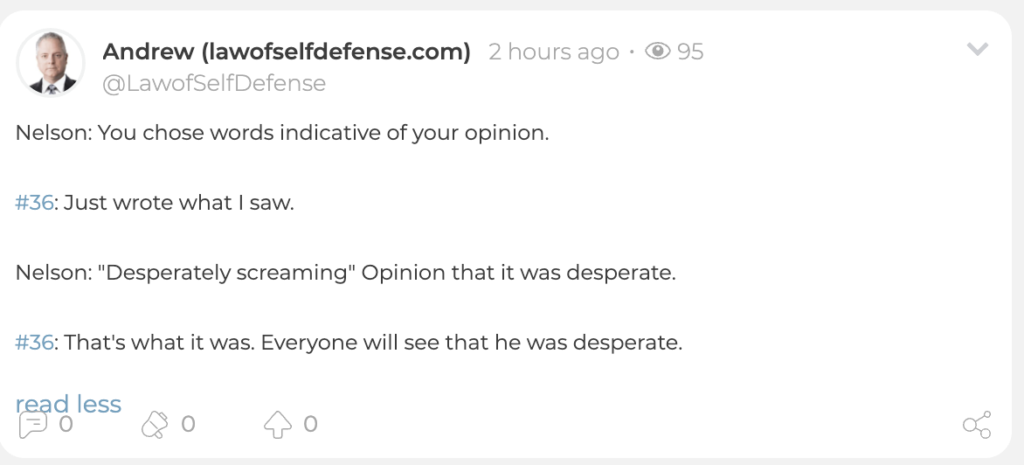
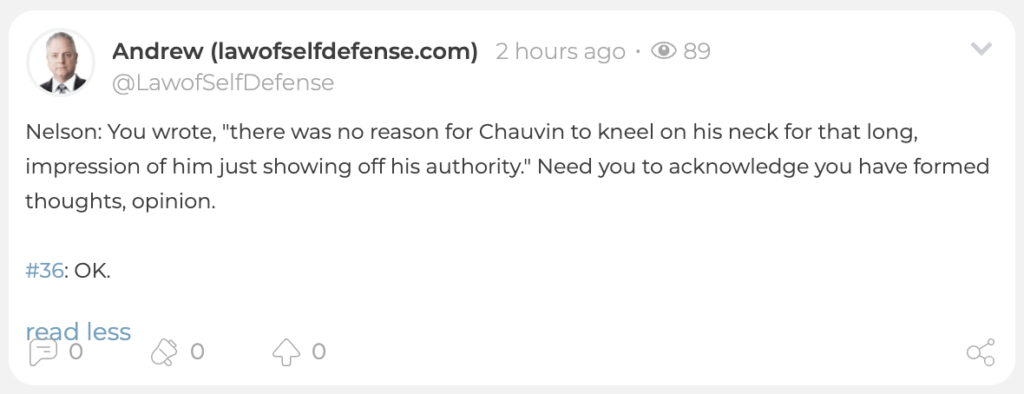


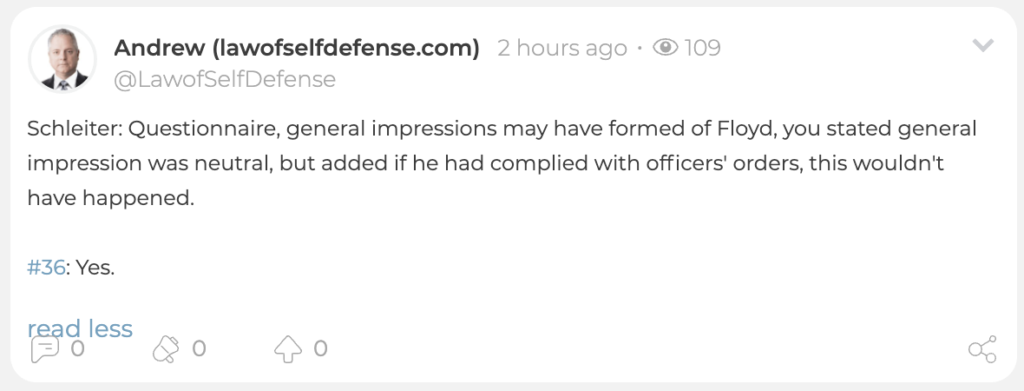









Comments
Pandering is harder to do when someone else’s life is on the line.
Andrew, thank you. Your descriptions of the pre-trial proceedings rival the best radio play-by-play calls of a good baseball game.
“When Floyd was on floor, Chauvin kneeling on neck the entire time, Floyd desperately screaming that he couldn’t breath, while other officers just let it happen, and bystanders screaming at Chauvin to get off his neck because he was killing him.”
________________
We now know that Floyd had severe heart disease and had just swallowed a huge, and fatal, dose of fentanyl. Floyd had repeatedly complained of having trouble breathing while he was standing up, and of course he was having trouble breathing, as his lungs were filling up with fluid. As for being desperate, he probably was. He knew he’d swallowed a huge amount of drugs. He could feel their effects on his body. He was undoubtedly scared. But there is zero evidence that anything that Chauvin did caused Floyd’s death. Chauvin’s knee wasn’t causing Floyd’s breathing problems, Floyd’s diseased heart and the massive drug overdose were doing that.
I’ve watched the videos, and they are hard to watch. I understand why someone would feel sympathy for Floyd. But that doesn’t change the fact that Floyd sealed his own fate that day when he swallowed that massive dose of fentanyl.
All of what you said is true, however if I’m on the jury, I’d have to be convinced that Floyd would have died that day even if he had not interaction with the police.
Of course Floyd wouldn’t have died that day “even if he had not [sic] interaction with the police”. He wouldn’t have swallowed the massive amount of fentanyl that he did in his attempt to hide/destroy the drugs in his possession if he hadn’t had an encounter with law enforcement. (Something Floyd has allegedly done at least once before landing him in the hospital.) So chances are the thug would have lived that day to terrorize the neighborhood businesses.
You thankfully aren’t on the jury with your justifications for finding Chauvin guilty.
I suspect you will be convinced once you have heard the medical testimony. There was no way that Floyd’s badly diseased heart was going to survive that much fentanyl.
First of all, Floyd cause the interaction with police by committing a crime. The police did not initiate the contact, but responded to a crime in progress call.
Second, it appears that Floyd created the deadly situation, himself, by ingesting the Fentanyl, and possibly meth, either after or shortly before contact with the police. He died while awaiting emergency medical help.
Now, the timeline on this incident begins at 2008 hrs, where police contact Floyd. Floyd is behaving oddly, but does not appear to be in any medical distress. He clearly states that he is not on any drugs. At 2014, the officers attempt to place Floyd in the back of their police unit. Floyd resists. He still is not displaying any signs of physical distress. At 2017 hrs, Chauvin arrives. He attempts to assist with placing Floyd into the police unit. Floyd begins to complain of shortness of breath. Fearing that Floyd might be having negative drug reaction, he is placed upon the ground and a call for medical aid is placed at 2020 hrs. Floyd is still struggling and is restrained,, part of which is the infamous knee to the neck. Some 1-2 minutes later, a call is made to expedite the response from EMS. Around, 2025 hrs, Floyd ceases struggling. At 2027 hrs, the paramedics arrive and Chauvin and the others release Floyd. They examine Floyd and he is then loaded aboard an ambulance and transported to the hospital. CPR begins, inside the ambulance, at approximately 2030 hrs, as it prepares to leave. At 2125 hrs, Floyd is pronounced dead, at the hospital.
The question that you have to ask yourself, is once the police made contact with Floyd, too investigate a felony crime, what were they supposed to do? Remember, these are police officers, not ER doctors, nurses or even EMTs. They did what they were supposed to do. They controlled Floyd, called and waited for EMTs to arrive. By the time emergency medical aid had arrived, Floyd was unresponsive. Upon the arrival of medical professionals [EMS] the police deferred to their directions. That Floyd was not able to be resuscitated, at the hospital, is unfortunate, but not the fault of the police offices involved.
So, Floyd ingests a triple fatal dose of fentanyl, as well as meth. He then presents an allegedly counterfeit bill for cigarettes and refuses to return the cigarettes. Police respond to a felony in progress call. They detain Floyd. Floyd denies using drugs. When he begins too show symptoms of a drug overdose, he is restrained and emergency medical help is called for. Before EMS arrives, he becomes unresponsive. EMS arrives within the next 2 minutes and Floyd is immediately placed into their care. They load him onto a stretcher, place him in the ambulance and begin CPR. He is immediately transported to the hospital.
So, again, what are the police supposed to do with Floyd? Turn him loose and leave him lying on the sidewalk. What happens if he gets up and runs into traffic and is hit by a vehicle? Not respond to the initial call? What???
Even if the arrest/detention/subdual contributed to floyd’s death, or was the only cause, it’s not a crime unless there was criminal intent/recklessness/negligence.
“All of what you said is true, however if I’m on the jury, I’d have to be convinced that Floyd would have died that day even if he had not interaction with the police.”
That’s not how the burden of proof is supposed to work. The prosecution has to convince you of things, the defense just has to raise a reasonable doubt. In this case that the officer may not have been responsible for Floyd’s death.
If you were on the jury, it would be your duty to be convinced that Officer Chauvin caused his death before convicting him.
George was complaining about not being able to breath long before he was on the ground. That was on the recently released tapes.
Yes, he complains repeatedly that he can’t breathe well before he is placed on the ground (which is something he also repeatedly requested). And we now know that the reason Floyd was having difficulty breathing was because his lungs were filling up with fluid as a result of his drug overdose. IOW, Floyd was having difficulty breathing while on the ground for the same reason he was having difficulty breathing while standing up: because his lungs were filling up with fluid from the drug overdose.
Andrew, what is the jury instruction you expect the judge to give regarding causation? Is there a standard instruction? If so, what does it provide?
Can’t imagine a better report,
I can’t imagine a report but I can definitely imagine a better defense.
I literally can’t comprehend the defense allowing some of these to be seated without objections.
Maybe defense is already angling for a mistrial, maybe to get a rehearing in a different venue? Like I stated on a previous post: seems like some of the potential jurors know some things about the case and have already formed some opinions on Chauvin’s guilt.
It appears that Judge Cahill may have informed counsel that so long as prospective juror will affirm they can be fair and impartial, they will not be removed for cause, no matter what their existing opinions on the case.
That seems like a pretty questionable decision to me. “Oh sure I think he’s guilty and should die in prison but I assure you I can still be objective” doesn’t seem like
What kind of opening does that leave for appeal if he does get convicted?
And I guess my question is, how exactly did the judge inform him, did he actually put that ruling in writing? If the defense doesn’t challenge them for cause and force the judge to overrule him and seat them, is it still appealable?
Andrew, again, thank you.
A question: it appears that defense counsel could use some help. Does Officer Chauvin have additional legal help that we’re just not seeing here, or is Mr. Nelson truly on his own?
Nelson has co-counsel sitting behind him. Attorney Amy Vos (sp?). Chauvin is seated beside Nelson. Not sure how big the total legal team is–I think it’s just Nelson and Vos (?). Legal team behind Zimmerman was substantial, in contrast, although we mostly only saw Don West and Mark O’Mara.
It may also be that due to COVID restrictions the court has limited the number of persons allowed in the courtroom. Can you tell anything about the prosecution side?
Nice summary, thanks!
Prosecutor: “What do you mean you’ll arrive at a verdict using evidence and reason? Pre-emptory challenge!”
The change to the 3rd-degree murder rule is so clearly results-oriented. The appeals court need this guy convicted and don’t care what damage they do to the law in order to accomplish it.